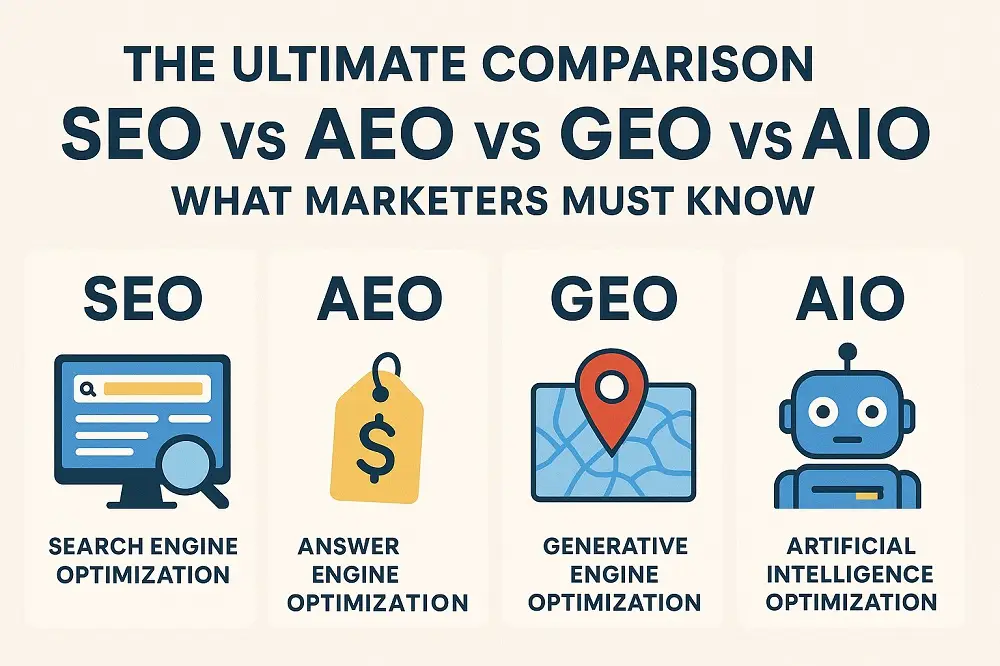
Search engines are no longer the only gateways to online visibility. With the rise of AI-driven search results and voice assistants, marketers must understand how SEO, AEO, GEO, and AIO work together to shape the future of digital marketing.
These four optimization approaches define how content appears on search results, AI-generated overviews, and voice responses. Knowing their differences helps you stay ahead in 2025’s evolving digital ecosystem.
This guide explains what each means, how they differ, and what marketers can do to adapt—without confusing jargon or unnecessary theory.
SEO remains the foundation of digital visibility. It focuses on improving a website’s rankings on search engines like Google and Bing using strategies such as:
According to BrightEdge Research, 68% of online experiences begin with a search engine, showing SEO’s lasting power.
However, SEO has evolved. Google’s algorithms now reward user experience, relevance, and intent more than keyword frequency. Modern SEO involves understanding what users need and delivering it efficiently.
💡 For a deeper look, check GK News Magazine’s post on SEO Trends 2025: How AI is Changing Search Engine Optimization.
AEO, or Answer Engine Optimization, is about optimizing your content to appear in direct answers — like Google’s featured snippets, voice assistants (Siri, Alexa), and AI chat results.
Instead of ranking in blue links, AEO helps your content become the answer.
For example, an article answering “What is AI-powered SEO?” might appear as a featured snippet if written clearly and precisely.
Google’s latest snippet updates (refer to Google’s Latest Update on Featured Snippets) now prioritize factual accuracy and user satisfaction signals.
AEO is vital for voice search and AI assistants, as more users ask questions conversationally instead of typing.
GEO, or Generative Engine Optimization, is the next frontier. It focuses on optimizing content for AI-generated summaries and overviews—like Google’s AI Overviews (SGE) or Bing’s Copilot results.
When users search, AI engines now create summaries instead of showing multiple links. GEO ensures your content is referenced or cited in those summaries.
Read more in Google AI Overviews Launch 2024, which explains how AI summaries are transforming organic search visibility.
According to Search Engine Journal, early studies show click-through rates from AI summaries may drop traditional SEO traffic by up to 18%, making GEO crucial for long-term visibility.
AIO focuses on using AI tools and algorithms to enhance and optimize digital marketing strategies. It’s not about search results but using AI to optimize your own processes.
For instance, AI can help analyze user behavior data, suggest better content outlines, and even personalize headlines to increase engagement.
AIO complements SEO, AEO, and GEO by making your marketing data-driven and future-ready.
| Feature | SEO | AEO | GEO | AIO |
| Full Form | Search Engine Optimization | Answer Engine Optimization | Generative Engine Optimization | Artificial Intelligence Optimization |
| Goal | Rank higher on search engines | Appear in featured answers or voice results | Get cited in AI-generated summaries | Use AI tools to optimize marketing |
| Focus | Keywords, backlinks, user experience | Queries, snippets, conversational search | AI models, structured, factual content | Automation, personalization, and prediction |
| Platform | Google, Bing, Yahoo | Google snippets, Alexa, Siri, Chatbots | Google SGE, Bing Copilot, AI overviews | AI marketing platforms |
| Outcome | Organic visibility | Voice & direct answers | AI summary inclusion | Data-driven strategy improvement |
Modern search is multi-layered. Instead of focusing only on one strategy, successful marketers integrate all four.
Here’s how they connect:
Together, they form a complete optimization ecosystem—crucial for 2025 and beyond.
Example: A well-optimized blog using SEO and AEO might appear in both Google’s top results and voice answers. Adding GEO strategies ensures it’s also referenced in AI Overviews. Meanwhile, AIO tools can track performance and suggest real-time updates.
Check Unveiling the Power of Digital Marketing for practical digital strategies aligned with these trends.
Traditional SEO focuses on algorithms. New-age optimization focuses on user satisfaction, relevance, and AI understanding.
As Google integrates AI into its core systems, the ability to optimize across SEO, AEO, GEO, and AIO will define who gets seen and who gets ignored.
Businesses that adapt early will enjoy:
AEO targets direct answers and voice searches, while GEO optimizes for AI-generated summaries like Google’s AI Overviews.
Yes. AEO builds on SEO. You need a strong SEO foundation for your content to appear in snippets and voice responses.
Because AI-generated overviews are replacing traditional SERPs, GEO ensures your site gets referenced or linked within those summaries.
AI-driven tools like Surfer SEO, MarketMuse, and ChatGPT-based analytics can assist in optimizing structure, tone, and content predictions.
Start with SEO fundamentals, then gradually integrate AEO and GEO as your site builds authority.
The world of search is evolving fast. SEO is no longer just about ranking; it’s about visibility across multiple intelligent platforms.
By combining SEO (visibility), AEO (answers), GEO (AI relevance), and AIO (intelligent optimization), marketers can future-proof their strategies and maintain digital dominance in 2025.
This balanced approach ensures that your brand doesn’t just appear—it stays relevant across every search touchpoint.
Published by GK News Magazine – your trusted source for technology, SEO, and digital innovation insights.